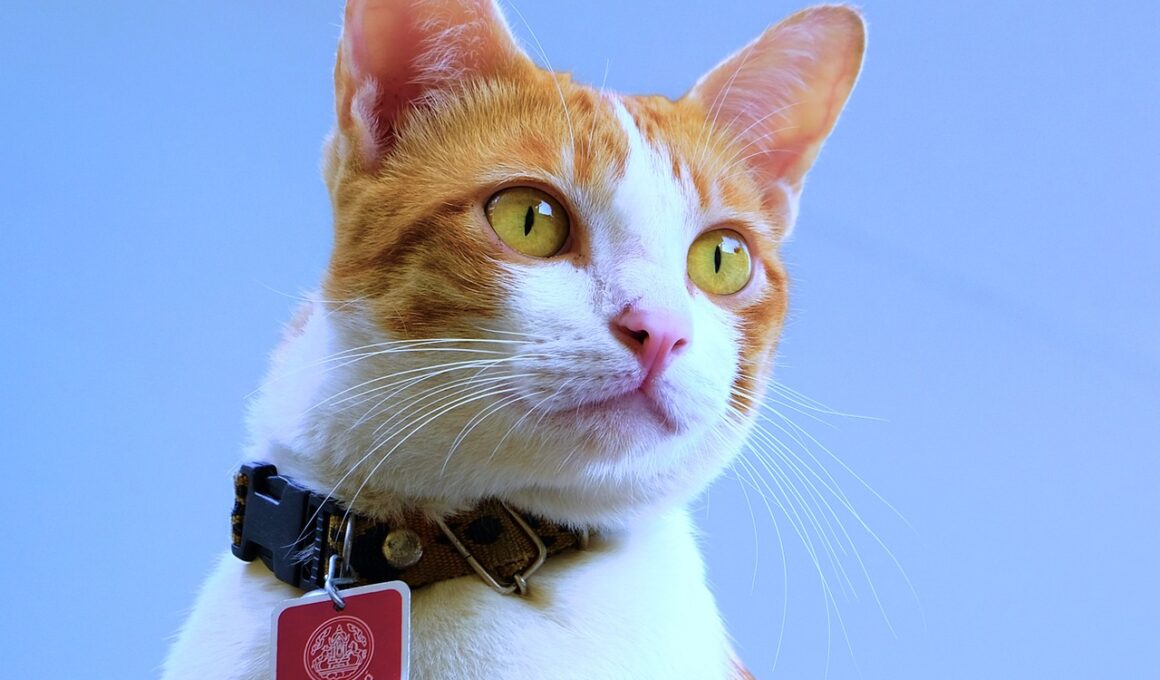Safety First: Features to Look for in Cat Collars and IDs
Choosing the right collar for your cat is crucial for ensuring their safety. A collar serves not only as a fashion accessory but also as a vital component in identification and safety measures. When selecting a collar, consider the material it’s made from, as some materials can be more comfortable for your cat. Look for collars that are made from soft, durable fabrics that won’t irritate your cat’s skin. Strong buckles are essential, as they provide reliability, ensuring the collar stays secure. Choosing the right size is equally important; a collar that is too loose can slip off, while one that is too tight can injure or choke your cat. A breakaway feature is highly recommended for outdoor cats, as it allows the collar to release if caught on something, preventing potential harm. Also, reflective elements can significantly enhance visibility during the night, helping to keep your cat safe. Ultimately, the right collar will balance comfort and safety, allowing your cat the freedom to explore their surroundings and return home safely.
Identification tags are vital for your cat’s safety. Ensure that the identification on the tag includes your contact information. A good ID tag is easily readable, durable, and securely attached. Consider adding your phone number and name on the tag to make it easier for someone to reach you if your cat goes missing. It’s also helpful to include a backup number or a trusted neighbor’s contact. The type of tag matters; metal tags tend to hold up better than plastic ones, which may wear down over time. You can also opt for a microchip, a more permanent form of ID. Microchips are tiny devices implanted under the skin, allowing your cat to be identified even if their collar comes off. Always consult with your veterinarian about the best options for microchipping. This process is quick and relatively painless. Ensure to keep your contact details updated with the microchip registry. Combined with a collar, a microchip acts like a safety net, providing two methods to ensure your cat can return home safely if they wander off.
Understanding Collar Styles
Cat collars come in various styles, each offering different features. Standard collars are adjustable and suitable for daily wear; these are often made from nylon or cotton. Breakaway collars are designed to snap open if pulled on, which helps prevent choking hazards. For adventurous outdoor cats, consider a padded collar that provides comfort during their escapades. Some collars come with added features like GPS trackers that allow you to monitor your cat’s location via a smartphone app. That’s particularly useful for anyone who has a cat that likes to roam. For those concerned about aesthetics, decorative collars come in beautiful colors or patterns, allowing you to express your cat’s personality. However, remember that functionality is more important than style. When browsing your options, always prioritize safety features. There are also collars designed for specific purposes, such as flea collars that repel pests or collars with bells that prevent your cat from sneaking up on birds. The right collar can reflect your cat’s personality while ensuring their safety in various environments.
Consider the daily environment when choosing a collar. Indoor cats may require simpler collars without extensive features. Cats that spend time outdoors should have more durable collars with safety features. Check the weather conditions in your area too. Waterproof collars can withstand rain and moisture. Avoid collars with small attachments that can get caught on objects easily. Observe how your cat reacts to their collar after you apply it. Some cats may be hesitant or try to remove it, which is a natural reaction. Take time to acclimate your feline friend to this new accessory by initially allowing them short periods with the collar on, gradually increasing the duration. Also, regularly verify that the collar fits properly as well as review its condition periodically for any wear and tear, ensuring it remains functional. Being aware of safety measures goes beyond the collar, as educating yourself on cat care will lead to a more secure environment. Always keep your cat’s safety top of mind to protect them effectively in the home and outdoor spaces.
Additional Considerations
When selecting a collar, also consider any medical issues your cat may have. For instance, some cats suffer from skin allergies that could be aggravated by certain materials. In these cases, opt for hypoallergenic collars made from gentle materials. Observe your cat for signs of irritation when you first introduce the collar. If they show discomfort, you may need to try a different style or brand. The collars should also fit comfortably, allowing for adjustments without being overly tight. Besides material considerations, assess the weight of the collar. Lightweight collars are often more comfortable for most cats, while larger, heavier options may cause discomfort and resistance in some felines. Always perform regular checks to ensure the collar remains in good condition. Check for fraying, looseness, or malfunctions in closure mechanisms. A collar that is not secure could easily slip off. Lastly, consult with your veterinarian for additional recommendations on collars that fit well for your cat’s individual needs, especially if your cat has specific health concerns that need addressing.
Finally, remember that the right collar isn’t only about safety; it can enhance your cat’s overall well-being. A well-fitted collar allows your cat to move freely and comfortably during play or exercise. Moreover, having an ID tag increases the likelihood of reuniting with your feline companion should they wander off. While safety and function are paramount, aesthetic elements shouldn’t be discounted. Choose a collar that speaks to your cat’s character and style. Some pet owners opt for personalized collars with their cat’s name embroidered, adding an even more personal touch to their safety gear. This can be beneficial in a busy household, distinguishing one pet from another. A pleasing design can also keep pet owners happy while ensuring their cat stays safe. You should also consider changing your cat’s collar seasonally to keep it fresh, ensuring that it remains in good repair. Safety needs to be balanced with style so your cat can express themselves while being secure. Engage with local community groups if you have further questions or seek advice on the best practices for collar usage.
Conclusion
In conclusion, choosing the right cat collar and ID is an essential part of responsible cat ownership. The safety features, material, fit, and additional functionalities are all factors that elevate the safety and comfort of your feline friend. Regular check-ups to assess the collar’s condition ensure that your pet is always safe. Reflect on your cat’s specific needs when selecting a collar, as individual differences in personality, activity levels, and environment all play a role. Equip your pet with an ID tag and consider a backup like microchipping to enhance the chance of a safe return if they get lost. Additionally, allow your cat to adjust to their collar slowly, always prioritizing their comfort and well-being. Investing in a quality collar will not only protect your cat but will also give you peace of mind as a pet parent. Remember to engage with your veterinarian for expert advice and recommendations based on your cat’s unique needs. Taking the time to research and explore the best options ensures that your cat is safe and stylish.
Overall, selecting a safe and suitable collar is a worthy investment in your cat’s safety. Always prioritize features that cater to your feline’s needs while considering their personality and preferred style. With proper diligence, you can find the perfect collar that provides both security and personality flair.


